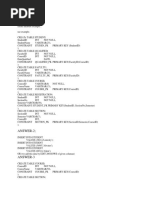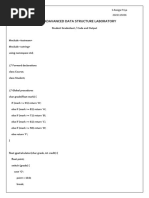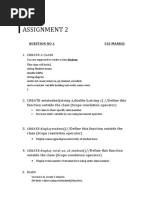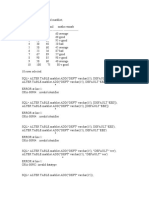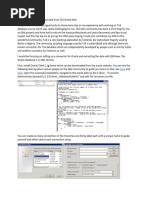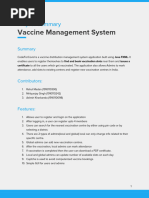hw2 Key
hw2 Key
Uploaded by
Qwerty DevCopyright:
Available Formats
hw2 Key
hw2 Key
Uploaded by
Qwerty DevOriginal Title
Copyright
Available Formats
Share this document
Did you find this document useful?
Is this content inappropriate?
Copyright:
Available Formats
hw2 Key
hw2 Key
Uploaded by
Qwerty DevCopyright:
Available Formats
CS5530/6530 Database Systems
Fall 2005
Key to Assignment 2 – Relational Languages: SQL and
Functional Dependencies
Due: Tue-Oct 4
Aside from regular exercises, your assignment contains practice exercises
which will help you cover the material in the textbook and lecture notes.
Only regular exercises will be corrected -- you should not turn in the
practice exercises. I will provide the key to practice exercises and I may
use some of these in your exams.
Some questions are intended only for students taking cs6530. Unless
explicitly stated in the question, cs5530 should not turn in these questions
– they will not be graded.
NOTE: A given query can be expressed in many different ways in SQL,
thus the solutions provided below give one, and in some cases 2
expressions for the queries. Other solutions are possible.
Regular Exercises
1. The university of Utah maintains a database with information about
students, professors and courses. The SQL descriptions of each relation
in the database is given below. A sample database is provided for you to
run your queries against. Besides the actual queries, you should also
submit electronically (using the submit system) the results of the queries.
create table Student (
Sid int,
Sname varchar(30),
GPA real,
Saddr varchar(100),
primary key (Sid)
);
create table Professor (
Pid int,
Pname varchar(30),
Paddr varchar(100),
primary key (Pid)
);
CS5530/6530 Database Systems -- Fall 2005 1
Assignment 2 key v1.1
create table Course (
Cid int,
Cname varchar(30),
required int,
primary key (Cid)
);
create table TA (
Sid int,
Cid int,
Year int,
foreign key (Sid) references Student(Sid),
foreign key (Cid) references Course(Cid)
);
create table Takes (
Sid int,
Cid int,
grade real,
Year int,
foreign key (Sid) references Student(Sid),
foreign key (Cid) references Course(Cid)
);
create table Teaches (
Pid int,
Cid int,
Year int,
foreign key (Pid) references Professor(Pid),
foreign key (Cid) references Course(Cid)
);
The meaning of these tables and their attributes should be obvious. Write the
following queries in SQL: [60 points]
a. List the names of all the people in the university database whose
address contains the string “salt”.
(select name from student where saddr LIKE '%salt%')
UNION ALL
(select name from professor where saddr LIKE '%salt%')
Note here the use of UNION ALL, which will keep duplicated names in
the results.
b. List the names of all professors, and the names of all the courses
they have taught (if any).
select pname,cname
from professor P OUTERJOIN teaches T JOIN course C
where P.pid = T.pid AND T.cid = C.cid
CS5530/6530 Database Systems -- Fall 2005 2
Assignment 2 key v1.1
c. List the names of professors that have not taught a course since
2000 in descending order of name.
select Pname
from Professor
where Pid not in (select Pid
from Teaches
where year > 2000)
order by Pname desc;
A more involved solution:
select Pname from
(select Pname
from Professor P, Teaches T
where P.pid = T.pid
group by Pname
having MAX(year) < 2000)
UNION
(select Pname
from Professor
where Pid not in (select Pid
from Teaches)
)
order by Pname desc
d. Since the database was just created, students have no GPAs in
their records (the Student table). Using the information about the
courses each student took, compute their GPA. Keep in mind that
when students audit courses, they do not receive a grade for that
course.
select sid, (sum(grade)/count(grade)) as gpa
from takes
group by sid
e. Using the GPAs computed in the previous query, update the GPA
column in the Student table.
UPDATE student
SET gpa = (SELECT (sum(grade)/count(grade))
FROM takes
WHERE Student.sid = Takes.sid);
NOTE: This is an example of a correlated update
f. List the name of all students whose GPA is different from 3.0.
(this should include students whose GPA is NULL)
CS5530/6530 Database Systems -- Fall 2005 3
Assignment 2 key v1.1
(Select name from student)
Minus
(Select name from student where gpa = 3.0)
g. List the name and address of students whose GPA are the highest
in the database.
Select name,gpa from student
Where gpa = (select max(gpa) from student)
h. List all CS courses and for each course, compute the average score
obtained by the students each time the course was taught. A
sample result could be:
Databases 2003 2.8
Databases 2004 3.5
Graphics 2001 4.0
Create view GradeAvg as
Select cid, year, (sum(grade)/count(grade)) as averg
from takes
group by cid, year;
select Cname, year, averg
from Course natural join GradeAvg;
An alternative would be to use a subquery:
select Cname, year, averg
from Course natural join
(Select cid, year, (sum(grade)/count(grade)) as averg
from takes
group by cid, year)
i. List the names of students and the names of the courses they
TA’ed but did not take.
create or replace view TANotTakes as
((select Sid, Cid
from TA)
minus
(select TA.Sid, Takes.Cid
CS5530/6530 Database Systems -- Fall 2005 4
Assignment 2 key v1.1
from Takes, TA
where Takes.Sid = TA.Sid));
select S.Sname, C.Cname
from Student S, Course C, TANotTakes TNT
where S.Sid = TNT.Sid and C.Cid = TNT.Cid;
What about the following query?
(select s.sname
from student s
where s.sid in (
select ta.sid
from ta,course
where ta.cid = course.cid))
MINUS
(select s.sname
from student s
where s.sid in
(select takes.sid
from takes,course
where takes.cid = course.cid));
j. [cs6530, and extra credit for 5530] List the names of all students
who have taken all the required CS courses.
(this requires division)
SELECT S.sname
FROM Student S
WHERE NOT EXISTS
((SELECT C.cid
FROM Course C
WHERE C.required = 1)
MINUS
(SELECT T.cid
FROM Takes T
WHERE S.sid=T.sid ));
2. [cs6530] Propose 2 improvements for the design of the university
database that address some of the complications you have encountered
while formulating the queries of question 1. (10 points)
There are several possible improvements to the tables defined above. For
example:
• You could disallow NULL values for grades, either by constraining the
attribute grade to be non-NULL
CS5530/6530 Database Systems -- Fall 2005 5
Assignment 2 key v1.1
create table Takes (
Sid int,
Cid int,
grade real NOT NULL,
Year int,
foreign key (Sid) references Student(Sid),
foreign key (Cid) references Course(Cid)
);
Or by creating a separate table for storing the grades.
• You could specify primary keys for TA, Takes and Teaches
• You could create a separate relation that keeps track of course sections:
create table CourseSection (
Cid int,
Year int,
Primary key (Cid,Year)
foreign key (Cid) references Course(Cid)
);
Assuming that a course is taught only once a year, i.e., the primary key for
CourseSection is (Cid,Year). To ensure the tuples in Takes are valid and
correspond to courses that were taught, you could create a foreign key from
Takes to CourseSection:
create table Takes (
Sid int,
Cid int,
grade real,
Year int,
primary key (Sid,Cid,Year),
foreign key (Sid) references Student(Sid),
foreign key (Cid,Year) references CourseSection(Cid,Year) );
And to ensure the tuples in Teaches are valid and correspond to courses that had
actual sections, you could create a foreign key from Teaches to CourseSection:
create table Teaches (
Pid int,
Cid int,
Year int,
primary key (Pid,Cid,Year),
foreign key (Pid) references Professor(Pid),
foreign key (Cid,Year) references Course(Cid,Year) );
CS5530/6530 Database Systems -- Fall 2005 6
Assignment 2 key v1.1
3. Express each of the following integrity constraints in SQL unless it is
implied by the primary and foreign key constraint; if so, explain how it is
implied. If the constraint cannot be expressed in SQL, say so. For each
constraint, state what operations (inserts, deletes, and updates on specific
relations) must be monitored to enforce the constraint. (20 points)
a. Every class has a minimum enrollment of 5 students and a
maximum enrollment of 30 students.
The takes table should be modified as follows:
CREATE TABLE Takes (
Sid int,
Cid int,
grade real,
Year int,
PRIMARY KEY (snum, cname),
foreign key (Sid) references Student(Sid),
foreign key (Cid) references Course(Cid)
CHECK ( ( SELECT COUNT (T.sid)
FROM Takes T
GROUP BY T.cid, T.year) >= 5),
CHECK ( ( SELECT COUNT (T.sid)
FROM Takes T
GROUP BY T.cid, T.year)<=30)
b. Every faculty member must teach at least two courses every year.
Note that we also need to include professors who did not teach any
course and whose pid is not present in the Teaches table.
CREATE ASSERTION TeachTwo
CHECK ( ( SELECT COUNT (*) FROM
(SELECT Professor P, Teaches T
WHERE P.pid = T.pid
GROUP BY T.Pid, T.year
HAVING COUNT (*) < 2))=0)
AND
(SELECT COUNT(*) FROM
(SELECT pid
FROM Professor
WHERE pid NOT IN (SELECT pid FROM
Teaches)))=0))
The assertion below is INCORRECT because it ignores professors who
never taught a course.
CS5530/6530 Database Systems -- Fall 2005 7
Assignment 2 key v1.1
CREATE ASSERTION TeachTwo
CHECK ( ( SELECT COUNT (*) FROM
(SELECT Professor P, Teaches T
WHERE P.pid = T.pid
GROUP BY T.Pid, T.year
HAVING COUNT (*) < 2)))=0)
c. Only faculty in that do not live in Salt Lake City can teach fewer
than 2 courses per year.
CREATE ASSERTION TeachLessThanTwo
CHECK (
NOT EXISTS(
(SELECT pid
FROM Professor P, Teaches T
WHERE P.pid = T.pid and P.Paddr LIKE '%salt lake
city%'
GROUP BY T.pid,T.year
HAVING COUNT (*) < 2)
UNION ALL
(SELECT pid
FROM Professor
WHERE P.Paddr LIKE '%salt lake%'
AND pid NOT IN (SELECT pid FROM Teaches))
))
d. Every student must take either Databases or Advanced Databases.
CREATE ASSERTION ReqDB
CS5530/6530 Database Systems -- Fall 2005 8
Assignment 2 key v1.1
CHECK (NOT EXISTS (select S.sid, count (*)
From Student S, Takes T
Where S.sid = T.sid and (T.cid = 1 or T.cid = 5)
Group by S.sid
Having count(*) < 1))
e. [cs6530] A student must be enrolled in more required courses than
in non-required courses.
CREATE ASSERTION ReqEnroll
CHECK (NOT EXISTS (
select SReq.sid from
(select T1.sid, count (*) AS C1
From Course C, takes T1
Where C.cid = T1.cid and C.required = 1
Group by T1.sid) SReq,
(select T2.sid, count (*) AS C2
From Course C, takes T2
Where C.cid = T2.cid and C.required = 0
Group by T2.sid) SNotReq
Where SReq.sid = SNotReq.sid AND SReq.C1 <= SNotReq.C2;))
4. Given the ER diagram below and a possible set of relations to represent
this database: (20 points)
Movies(title, year, length)
Sequel(title_orig,year_orig,title_seq,year_seq) – fkeys into Movies
Owns(title, year, studio_name) – fkey(title,year)Æ Movies;
fkey(studio_name)ÆStudios
Studios(name, address)
StarsIn(title, year, star_name, salary) – fkey(title, year)Æ Movies;
fkey(star_name)ÆStars
Stars(name, address)
a. Write in SQL statements to create these relations. You need to specify
all the keys and foreign keys.
Create table Movies (
Title varchar(30),
Year int,
Length real,
Primary key (title, year)
);
Create table Sequel (
Title_orig varchar(30),
Year_orig int,
Title_seq varchar(30),
CS5530/6530 Database Systems -- Fall 2005 9
Assignment 2 key v1.1
Year_seq int,
Primary key (Title_orig,Year_orig,Title_seq,Year_seq),
Foreign key (title_orig,year_orig) references Movies(title,year),
Foreign key (title_seq, year_seq) references Movies(title,year)
);
Create table Studios (
Name varchar(30) PRIMARY KEY,
Address varchar(100)
);
Create table Owns (
Title varchar(30),
Year int,
Studio_name varchar(30),
Primary key(title,year,studio_name),
Foreign key (title,year) references Movies(title,year),
Foreign key (studio_name) references Studios(name)
);
Create table Stars (
Name varchar(30) PRIMARY KEY,
Address varchar(100)
);
Create table StarsIn (
Title varchar(30),
Year int,
star_name varchar(30),
salary real,
Primary key (title,year,star_name),
Foreign key (title,year) references Movies(title,year),
Foreign key (star_name) references Stars(name)
);
b. Suppose your database system does not allow the definition of foreign
keys. How would you express the foreign keys above using the other
integrity constraints checking mechanisms in SQL?
You would need to use assertions. For example, to enforce the following
foreign key in the Owns relation:
Foreign key (studio_name) references Studios(name)
you could create the following assertion:
CS5530/6530 Database Systems -- Fall 2005 10
Assignment 2 key v1.1
CREATE ASSERTION
CHECK (NOT EXISTS (
(SELECT studio_name
FROM Owns
WHERE studio_name NOT IN
(SELECT name from Studios))))
We might suppose that we could simulate a referential integrity constraint
by an attribute-based CHECK constraint that requires the existence of the
referred value. The following is an erroneous attempt to simulate the
foreign key constraint in the Owns relation:
Studio_name varchar(30)
CHECK ( studio_name IN (SELECT name FROM Studios))
This constraint guarantees that if we add a new tuple or modify the
studio_name value of a tuple in Owns, the update is only allowed if the
value for studio_name is in the Studios table. However, if we change the
Studios relation, say, by deleting a tuple for one studio, this is invisible to
the CHECK constraint above. Thus, the deletion is permitted even though
the attribute-based CHECK constraint on studio_name is now violated
Unlike value- and tuple-based constraints, which are only checked when
the table in which they were defined is updated, assertions are checked
when any of the tables they refer to is modified.
c. [cs6530] Write an SQL query that lists all the sequels for the movie
Friday the 13th which was released in 1980.
(this requires a recursive query)
WITH RECURSIVE Mov(Title_orig, Year_orig, Title_seq, Year_seq) AS
(select S1.Title_orig, S1.Year_orig, S1.Title_seq, S1.Year_seq
From Sequel S1
Where S1.Title_orig = ‘Friday the 13th’ and S1.Year_orig = 1980)
UNION ALL
(select S2. Title_orig, S2.Year_orig, M1.Title_seq, M1.Year_seq
From Sequel S2, Mov M1
Where S2. Title_seq = M1.Title_orig and S2.Year_seq = M1.Year_orig)
Select * from Mov;
Another alternative:
WITH RECURSIVE AllSequels(Title_orig, Year_orig, Title_seq, Year_seq) AS
(select S1.Title_orig, S1.Year_orig, S1.Title_seq, S1.Year_seq
CS5530/6530 Database Systems -- Fall 2005 11
Assignment 2 key v1.1
From Sequel S1)
UNION ALL
(select S2. Title_orig, S2.Year_orig, AS.Title_seq, AS.Year_seq
From Sequel S2, AllSequels AS
Where S2. Title_seq = AS.Title_orig and S2.Year_seq = AS.Year_orig)
Select Title_seq, Year_seq from AllSequels
Where Title_orig = ‘Friday the 13th’ and Year_orig = 1980;
salary
year address
title
sequel
length name
Sequel Movies Stars-in Stars
original
Owns
Studios
name address
Practice Exercises
Consider the following schema from Assignment 1:
Suppliers(sid: integer, sname: string, address: string)
Parts(pid: integer, pname: string, color: string)
Catalog(sid: integer, pid: integer, cost: real)
The key fields are underlined, and the domain of each field is listed after the field
name. Therefore sid is the key for Suppliers, pid is the key for Parts, and sid and pid
together form the key for Catalog. The Catalog relation lists the prices charged for
CS5530/6530 Database Systems -- Fall 2005 12
Assignment 2 key v1.1
parts by Suppliers. Write the following queries in SQL:
1. Find the names of suppliers who supply some red part.
2. Find the sids of suppliers who supply some red or green part.
3. Find the sids of suppliers who supply some red part or are at 221 Packer Street.
4. Find the sids of suppliers who supply some red part and some green part.
5. Find the sids of suppliers who supply every part.
6. Find the sids of suppliers who supply every red part.
7. Find pairs of sids such that the supplier with the first sid charges more for
some part than the supplier with the second sid.
8. Find the pids of parts supplied by at least two different suppliers.
9. Find the pids of the most expensive parts supplied by suppliers named
Yosemite Sham.
10. Find how many suppliers supply some red part.
Answer:
1. SELECT S.sname
FROM Suppliers S, Parts P, Catalog C
WHERE P.color=’red’ AND C.pid=P.pid AND C.sid=S.sid
2. SELECT C.sid
FROM Catalog C, Parts P
WHERE (P.color = ‘red’ OR P.color = ‘green’)
AND P.pid = C.pid
3. SELECT S.sid
FROM Suppliers S
WHERE S.address = ‘221 Packer street’
OR S.sid IN ( SELECT C.sid
FROM Parts P, Catalog C
WHERE P.color=’red’ AND P.pid = C.pid )
4. SELECT C.sid
FROM Parts P, Catalog C
WHERE P.color = ‘red’ AND P.pid = C.pid
AND EXISTS ( SELECT P2.pid
FROM Parts P2, Catalog C2
WHERE P2.color = ‘green’ AND C2.sid = C.sid
AND P2.pid = C2.pid )
5. SELECT C.sid
FROM Catalog C
WHERE NOT EXISTS (SELECT P.pid
FROM Parts P
WHERE NOT EXISTS (SELECT C1.sid
FROM Catalog C1
CS5530/6530 Database Systems -- Fall 2005 13
Assignment 2 key v1.1
WHERE C1.sid = C.sid
AND C1.pid = P.pid))
6. SELECT C.sid
FROM Catalog C
WHERE NOT EXISTS (SELECT P.pid
FROM Parts P
WHERE P.color = ‘red’
AND (NOT EXISTS (SELECT C1.sid
FROM Catalog C1
WHERE C1.sid = C.sid AND
C1.pid = P.pid)))
7. SELECT C1.sid, C2.sid
FROM Catalog C1, Catalog C2
WHERE C1.pid = C2.pid AND C1.sid <> C2.sid
AND C1.cost > C2.cost
8. SELECT C.pid
FROM Catalog C
WHERE EXISTS (SELECT C1.sid
FROM Catalog C1
WHERE C1.pid = C.pid AND C1.sid <> C.sid )
9. SELECT C.pid
FROM Catalog C, Suppliers S
WHERE S.sname = ‘Yosemite Sham’ AND C.sid = S.sid
AND C.cost ≥ ALL (Select C2.cost
FROM Catalog C2, Suppliers S2
WHERE S2.sname = ‘Yosemite Sham’
AND C2.sid = S2.sid)
10. SELECT COUNT(S.sid)
FROM Suppliers S, Parts P, Catalog C
WHERE P.color=’red’ AND C.pid=P.pid AND C.sid=S.sid
CS5530/6530 Database Systems -- Fall 2005 14
Assignment 2 key v1.1
You might also like
- Apache Cassandra Administrator Associate - Exam Practice TestsFrom EverandApache Cassandra Administrator Associate - Exam Practice TestsNo ratings yet
- CIS Microsoft SQL Server 2016 Benchmark v1.3.0Document69 pagesCIS Microsoft SQL Server 2016 Benchmark v1.3.0Jesus David Duarte PradoNo ratings yet
- 7 - Problem Assignments PDFDocument5 pages7 - Problem Assignments PDFAnonymous zdY202lgZY67% (3)
- Department of Cyber Security: Faculty of Computing and Artificial IntelligenceDocument6 pagesDepartment of Cyber Security: Faculty of Computing and Artificial Intelligencefarhan mahmood0% (1)
- Relation:-A Relation /table Is Set of Records in The Form of TwoDocument53 pagesRelation:-A Relation /table Is Set of Records in The Form of TwoX BoyNo ratings yet
- Exam 1 - Miguel SolisDocument11 pagesExam 1 - Miguel Solisapi-482280770No ratings yet
- Cs2258 Database Management Systems LabDocument12 pagesCs2258 Database Management Systems LabDhayaNo ratings yet
- Database Systems IiDocument3 pagesDatabase Systems Iicyrus100% (1)
- IMSE 685 Manufacturing Information Systems Homework Assignment #3Document11 pagesIMSE 685 Manufacturing Information Systems Homework Assignment #3MARYAM shahNo ratings yet
- SQL QueriesDocument27 pagesSQL Queriespuvi ththiraNo ratings yet
- Relational ModelDocument17 pagesRelational ModelpacharneajayNo ratings yet
- DBMS RecordDocument58 pagesDBMS RecordPranava PranuNo ratings yet
- Database Managment SystemDocument18 pagesDatabase Managment SystemanirudhsahaimathurNo ratings yet
- Final F02Document4 pagesFinal F02Farah KhanNo ratings yet
- Lab 01 ExercisesDocument4 pagesLab 01 Exerciseslijames800No ratings yet
- Informatics Practices Revision BookDocument5 pagesInformatics Practices Revision Bookdebasissahu09471No ratings yet
- DBMS - GTU Paper SolutionDocument16 pagesDBMS - GTU Paper SolutionShiv PatelNo ratings yet
- Relational Model SlidesDocument30 pagesRelational Model SlidesoguztemelliNo ratings yet
- DBMS RecordDocument76 pagesDBMS RecordPranava PranuNo ratings yet
- Solution css223Document8 pagesSolution css223chiedzad madondoNo ratings yet
- Lab Manual Week02Document3 pagesLab Manual Week02waliaslam2002No ratings yet
- Lab Exercise-2Document2 pagesLab Exercise-2Priangshu PaulNo ratings yet
- Tut 6 QuestionsDocument4 pagesTut 6 QuestionsSơn Lê VănNo ratings yet
- Assignment 44Document3 pagesAssignment 44Zakia SohailNo ratings yet
- 02 SQLDocument7 pages02 SQLNaman YadavvvNo ratings yet
- Elmasri 6e - ISM 01Document5 pagesElmasri 6e - ISM 01Aliaa TarekNo ratings yet
- Mysql Tutorial: Introduction To DatabaseDocument22 pagesMysql Tutorial: Introduction To Databaseمحمد طلال الدبإغNo ratings yet
- Java SYMarks Packages, Compiling and CodeDocument6 pagesJava SYMarks Packages, Compiling and Codesanjuwagh2909No ratings yet
- DBMS Questions MCQDocument2 pagesDBMS Questions MCQbishwajeetit6331No ratings yet
- COMP 302 Database SystemsDocument31 pagesCOMP 302 Database Systemsabdalrahmantouny63No ratings yet
- ASSIGNMENT 2 ImbDocument8 pagesASSIGNMENT 2 Imbsaurav singhNo ratings yet
- Ensf 480 Midterm 2018 SolutionsDocument6 pagesEnsf 480 Midterm 2018 Solutionsmaitrungtuan2002No ratings yet
- Tut8 QPO QaDocument7 pagesTut8 QPO Qa6r8bwn769sNo ratings yet
- Tutorial 6: Relational Def / Updates / TriggersDocument10 pagesTutorial 6: Relational Def / Updates / Triggersmars chouNo ratings yet
- 03 Advanced SQLDocument65 pages03 Advanced SQLcharbel marunNo ratings yet
- 学生 课程 成绩 教师50个常用sqlDocument22 pages学生 课程 成绩 教师50个常用sql1120217099No ratings yet
- Test 1 KeyDocument5 pagesTest 1 Keyabdelrahman salahNo ratings yet
- Relational AlgebraDocument5 pagesRelational Algebraapi-3717970No ratings yet
- 03 Advanced SQL AnnotateddiDocument77 pages03 Advanced SQL Annotateddidivakarmass444No ratings yet
- IT232 - ProjectDocument10 pagesIT232 - ProjectwazirkqasemNo ratings yet
- Unit 3 and 4 Que BankDocument11 pagesUnit 3 and 4 Que BankARNYNo ratings yet
- Inheritance__1_Document7 pagesInheritance__1_listypop75No ratings yet
- Assignment 2 OOPDocument3 pagesAssignment 2 OOPTayyaba Rahmat100% (2)
- 521 HW3Document23 pages521 HW3namanwhoNo ratings yet
- Lab ManualDocument6 pagesLab ManualAsian AnalysisNo ratings yet
- Database Management SystemDocument54 pagesDatabase Management SystemSamir ThapaNo ratings yet
- OOP Theory Mid P2 SolDocument10 pagesOOP Theory Mid P2 Solkalmaaa66No ratings yet
- C++ Programming Tutorial Part II: Object-Oriented ProgrammingDocument215 pagesC++ Programming Tutorial Part II: Object-Oriented ProgrammingSsdsNo ratings yet
- Fall 2022 - CS101 - 2Document4 pagesFall 2022 - CS101 - 2Lisa PowellNo ratings yet
- It5412 Adavanced Data Structure LaboratoryDocument8 pagesIt5412 Adavanced Data Structure Laboratoryrasigapriyas32No ratings yet
- CS304 (P) - Sample PaperDocument14 pagesCS304 (P) - Sample Papertaha tahaNo ratings yet
- DSA456 Midterm Dilli PDFDocument8 pagesDSA456 Midterm Dilli PDFnavneetkaur12482No ratings yet
- 3 SDocument14 pages3 SSaadia MobeenNo ratings yet
- Sample Ut2Document3 pagesSample Ut2akshatkumar9112008No ratings yet
- Lab 1Document2 pagesLab 1mo2419270No ratings yet
- Assignment 2: Question No 1 (20 Marks)Document3 pagesAssignment 2: Question No 1 (20 Marks)Malik RavelNo ratings yet
- LAB 3: Object-Oriented Programming: You Need To Implement The Following Class Diagram Using PythonDocument5 pagesLAB 3: Object-Oriented Programming: You Need To Implement The Following Class Diagram Using PythonMaRoua AbdelhafidhNo ratings yet
- Java Programming Tutorial With Screen Shots & Many Code ExampleFrom EverandJava Programming Tutorial With Screen Shots & Many Code ExampleNo ratings yet
- Apache Cassandra Developer Associate - Exam Practice TestsFrom EverandApache Cassandra Developer Associate - Exam Practice TestsNo ratings yet
- Mekdela Amba UniversityDocument15 pagesMekdela Amba UniversityAbera BrhanuNo ratings yet
- Globally Distributed, Secure MongoDB With Azure Cosmos DBDocument23 pagesGlobally Distributed, Secure MongoDB With Azure Cosmos DBspringleeNo ratings yet
- SQL Class 12 PPT StudyDocument34 pagesSQL Class 12 PPT StudyShawrya SaxenaNo ratings yet
- Adv RDBDocument7 pagesAdv RDBKunal ChaudhariNo ratings yet
- L1Document27 pagesL1anshikam220No ratings yet
- What Is Explicit and Implicit Cursor and Examples? AnsDocument2 pagesWhat Is Explicit and Implicit Cursor and Examples? AnsredroNo ratings yet
- Database Programming With SQL Section 4 QuizDocument11 pagesDatabase Programming With SQL Section 4 QuizJosé Obeniel LópezNo ratings yet
- Oracle Interview QuestionDocument87 pagesOracle Interview QuestionfahdaizazNo ratings yet
- Give Me All MySQL Commands Syntax in DetailDocument5 pagesGive Me All MySQL Commands Syntax in Detailshaik shaheerNo ratings yet
- DBMS Important Questions and AnswersDocument12 pagesDBMS Important Questions and AnswersLakshmi SarvaniNo ratings yet
- Week 5 DbmsDocument10 pagesWeek 5 DbmsjomejiNo ratings yet
- JoinDocument15 pagesJoinShantanu DashNo ratings yet
- SQLDocument13 pagesSQLRadhakrishnan__7263No ratings yet
- SQL Query Tuning For SQL Server PDFDocument7 pagesSQL Query Tuning For SQL Server PDFMarcio SilvaNo ratings yet
- Puja N FinalDocument117 pagesPuja N Finalmasev35300No ratings yet
- Java Persistence API: Momtajul KarimDocument59 pagesJava Persistence API: Momtajul Karimifte5104385No ratings yet
- Ss 2 Data Processing First Term E-NoteDocument48 pagesSs 2 Data Processing First Term E-NoteJesseNo ratings yet
- How To Connect and Extract Data From T24 Oracle XMLDocument4 pagesHow To Connect and Extract Data From T24 Oracle XMLZakaria AlmamariNo ratings yet
- Database Programming With SQL Section 3 QuizDocument13 pagesDatabase Programming With SQL Section 3 QuizJosé Obeniel LópezNo ratings yet
- AnalysisReport 1709047325596Document45 pagesAnalysisReport 1709047325596snikaNo ratings yet
- Recommended Learning PathsDocument3 pagesRecommended Learning Pathsprasad velgalaNo ratings yet
- National Institute of Technology, Calicut: Department of Architecture and PlanningDocument20 pagesNational Institute of Technology, Calicut: Department of Architecture and PlanningDriya HariNo ratings yet
- File Oriented System Vs DbmsDocument6 pagesFile Oriented System Vs DbmsHema AroraNo ratings yet
- MCS 043Document5 pagesMCS 043Tuhin PaulNo ratings yet
- 9 - Databases New Updated (MT-L)Document19 pages9 - Databases New Updated (MT-L)mon pereNo ratings yet
- DBMS Lab 2Document12 pagesDBMS Lab 2chauhansumi143No ratings yet
- SQL-An A-Z SQL CommandsDocument3 pagesSQL-An A-Z SQL Commandskamitsi100% (2)
- DBMS Vaccine Management System codeForCovidDocument12 pagesDBMS Vaccine Management System codeForCovidNishant PrasadNo ratings yet
- SjoinDocument13 pagesSjoinsahanashriNo ratings yet























